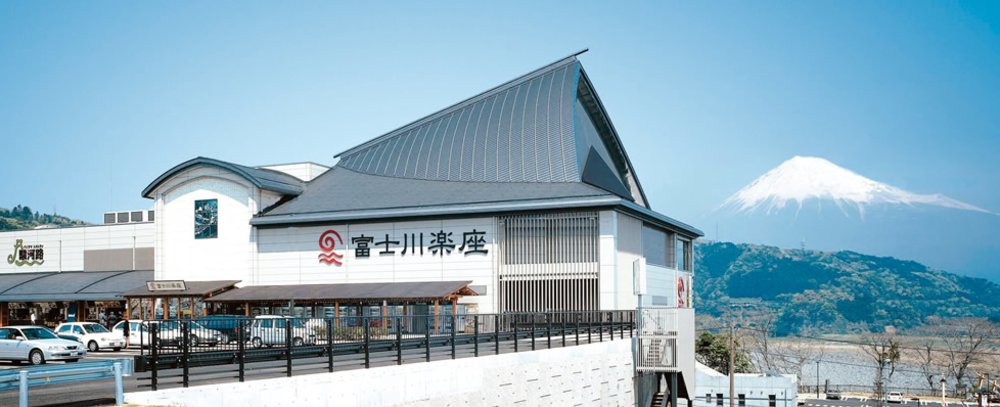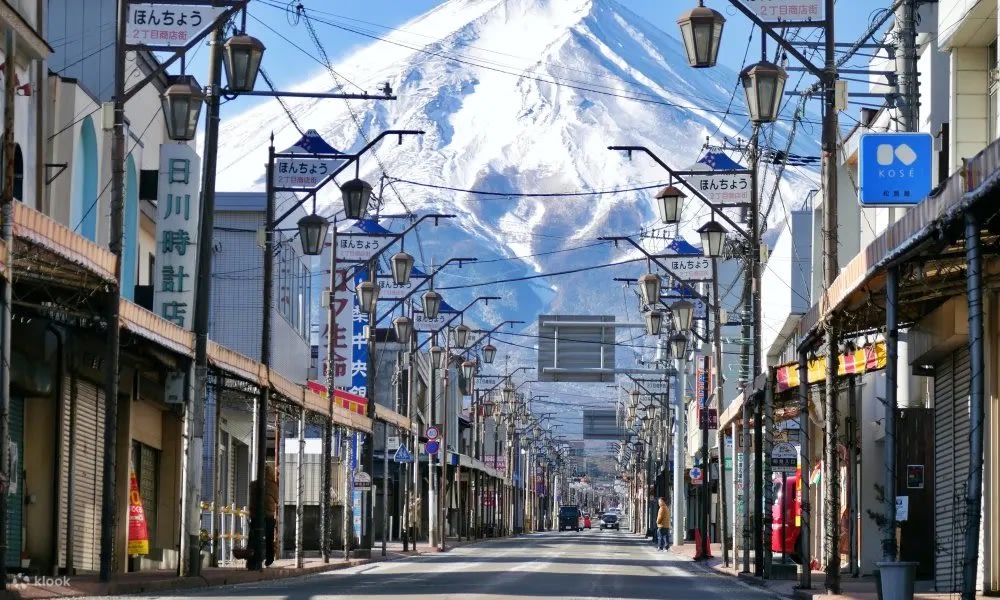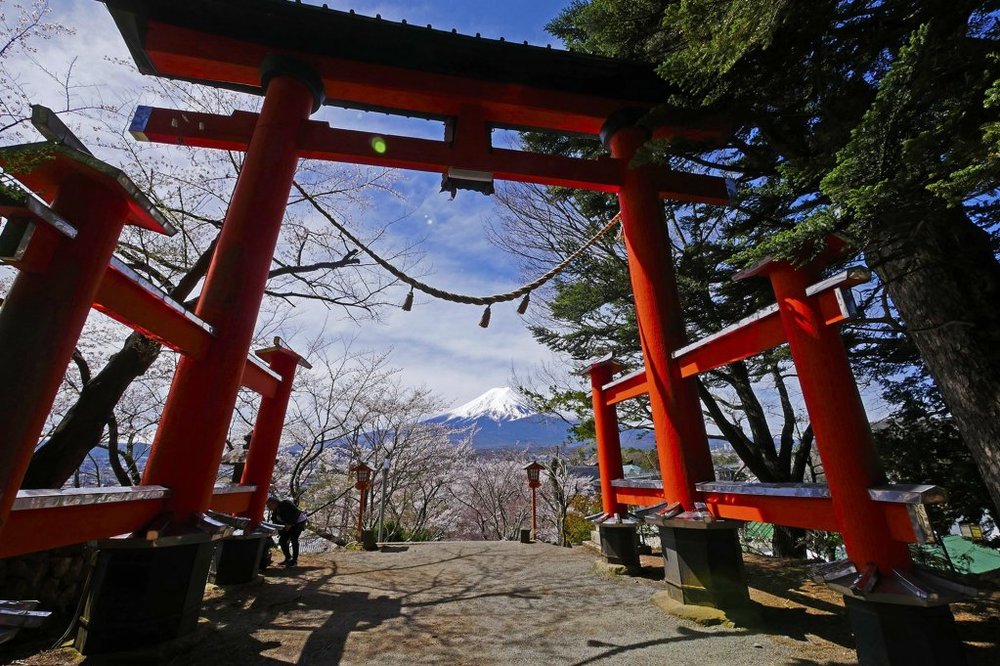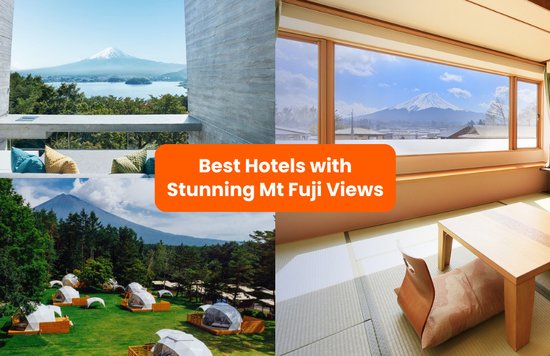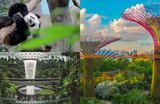4D3N Mt. Fuji Road Trip Itinerary From Tokyo: Fuji Five Lakes, Lake Kawaguchiko, and Surrounds
Standing at 3,776 metres tall, Mt. Fuji (or Fuji-san, as the locals affectionately call the mountain) is one of Japan’s most iconic symbols. A UNESCO World Heritage site, Mt. Fuji is also one of Japan’s ‘three holy mountains’! It’s even visible from Tokyo on a clear day, from places like Shibuya Sky, and Roppongi Hills Observation Deck.
P/S: Did you know that Mt. Fuji is actually an active volcano? It last erupted in the early 1700s, forming five lakes — which are commonly known as the Fuji Five Lakes. Located in the Yamanashi prefecture, the Fuji Five Lakes area has so much to see and do — especially on an easy road trip from Tokyo.
Most people discover the region on a day trip which, to be fair, is very do-able. However, we recommend setting aside the time — with this 4D3N itinerary! — to see more of the area! You can choose to either a) drive from Tokyo, or b) take the new Fuji Excursion train to Kawaguchiko, and pick up your car from there. We recommend doing the latter to avoid the notorious traffic jams on the expressway out of Tokyo.
Japan car rental
Set aside any concerns about the language barrier by booking your rental car with Klook! Easily choose the type of vehicle you want; and easily choose your insurance (trust us, go for the full package), add-ons (think: car seats, English GPS, and whatnot). You can even do a one-way rental, e.g. pick up your car at Kawaguchiko, and return it back at Tokyo.
You’ll even be able to enjoy free cancellations up to a certain time, allowing you to make any adjustments to your itinerary on the go. Sweet, huh!
#KlookTip: Don’t forget to layer on Klook’s promo codes (they roll out new ones every month!) for extra savings.
#KlookTips for driving in Japan
- You’ll need an International Driver’s Permit (IDP) to drive in Japan. Apply for it online (takes up to ten working days), or receive it on the spot when you apply directly at the Automobile Association in Singapore. The validity of each IDP is one year from the date of issue.
- Get an electronic toll collection (ETC) card together with your car rental. These cards offer a seamless way to pay highway tolls; think of them as regular transport cards, but for car tolls. You’ll usually settle the toll bills when you return your car.
- If you’re planning on doing a long road trip, consider getting an expressway pass.
- Take note of speed limits: it’s usually 60 km/h on regular roads, and 100km/h on expressways.
- Stretch your legs at rest stops, which have a lot to offer! Check out Fujikawa-Rakuza, which sells seafood delicacies from Suruga Bay, and a farmer’s market with locally grown products. It even has a traditional Japanese tearoom, and a Ferris wheel.
- If you’d like to be extra prepared, familiarise yourself with these Japanese road signs.
- You’ll be driving on the left-hand side of the road.
- Children under six years of age must be in child seats; easily add them on when you rent your car.
- If you get into an accident, call the police by dialling 110. If you need an ambulance, call 119.
Best time to plan a Mt. Fuji Road Trip
- However, for the best chances to see Mt. Fuji (think: mostly clear blue skies, and Mt. Fuji’s famous snowcap!), plan your road trip for November and December.
- If you’d like to climb Mt. Fuji itself, take note that climbing season is only from July to early September. Peak climbing season is from late July to late August.
- Bookmark the 24-hour Mt. Fuji live cameras to check the weather outlook.
Day 1
Shimoyoshida Honcho Street
Distance: 94.9 kilometres from Tokyo; 4.2 kilometres from Kawaguchiko station
Drive duration: 1 hour 21 minutes from Tokyo; 12 minutes from Kawaguchiko station
Collect your car in Tokyo, and make your way to Shimoyoshida Honcho Street. Snag a classic photo of Mt. Fuji here, framed by two rows of retro shops and utility poles dangling overhead power lines. The old-school shops here are mostly textile in nature — as the area was once a thriving textile production region — interspersed between a variety of nostalgic cafés.
Arakuyama Sengen Park (Chureito Pagoda)
Distance: 1.9 kilometres
Drive duration: 7 minutes
Boasting scenic views, Arakuyama Sengen Park extends from the bottom of Mt. Arakurayama up to an observation deck.
Must-do at Arakuyama Sengen Park
Feast your eyes on gorgeous views
Arakuyama Sengen Park offers a magnificent view of Mt. Fuji, Fujiyoshida city, and the five-storey Chureito Pagoda — all in one frame. To get to the observation deck, however, you’d have to climb almost 400 steps. Trust us, it’s more than worth it! The scene is especially beautiful in spring and autumn too.
#KlookTip: Parking is free here, except during sakura season. If you visit outside of sakura season, you’ll also be able to drive halfway up to the pagoda — considerably reducing the number of steps to the top.
Other Arakuyama Sengen Park highlights
- Check out the Fuji panoramic platform
- View Mt. Fuji through Arakura Fuji Sengen Jinja Shrine’s torii gate
- Visit the Shiogama shrine
Lake Kawaguchiko
Distance: 7.9 kilometres
Drive duration: 17 minutes
End the day at Lake Kawaguchiko, the most famous of the Fuji Five Lakes.
Must-do at Lake Kawaguchiko
See if you can capture the ‘Reverse Fuji’ view
Photo credit: Klook
The ‘Reverse Fuji’ view refers to a shot where Mt. Fuji is reflected on Lake Kawaguchiko. This is best viewed in the morning, when the waters are calm and without many ripples.
Other Lake Kawaguchiko highlights
- Prance along Oishi Park’s flower street
- Take a stroll along the lake’s shores
- View intricate kimono fabrics at Itchiku Kubota Art Museum
- Try hoto noodles — thick and flat udon in miso soup — at Hotou Fudo, a specialty restaurant near Kawaguchiko station
- See the ‘prettiest convenience store in the world’, where Mt. Fuji looms above a Lawson convenience store — just 100 metres from the Kawaguchiko station
- Stroll through the scenic Momiji corridor in autumn
- Dine at Sanrokuen, a traditional restaurant that serves charcoal-grilled Kushiyaki (skewers)
- Experience driving a cute Choro-Q mini car
- Learn more at the Fujisan World Heritage Centre
- Go on a guided walk through the Funatsu Lava Tree Molds
- Buy souvenirs from Fujiyama Cookie, which sells Mt. Fuji-shaped cookies
- Take the Mt. Fuji Panoramic Ropeway
- Go on a 20-minute sightseeing cruise
- Check out Tenku no Torii, the ‘torii gate in the sky’
Stay at: Any of these hotels, ryokans or glamping sites with Mt. Fuji views except Hotel Mt. Fuji, which is located further away.
Day 2
Lake Saiko
Distance: 8.2 kilometres
Drive duration: 14 minutes
One of the five lakes, Lake Saiko is much smaller than Lake Kawaguchiko — with views of Mt. Fuji only from its Western shores.
#KlookTip: If you’re after more panoramic views, make a detour to Fujiyama Twin Terrace on the way to Lake Saiko.
Must-do at Lake Saiko
Explore the caves
The area around Lake Saiko has multiple caves, three of which can be explored by the public. The Bat Cave is the largest — and most interesting! — of the lot, with big chambers and tunnels. The Ice Cave stays true to its name, with cold temperatures throughout the year. In winter, check out the stunning ice pillars that form in the cave. The interior temperature of the Wind Cave hovers around zero degrees celsius throughout the year, and sports interesting lava formations. Interestingly, you won’t be able to hear an echo in the wind cave, as its porous basalt walls absorb all sound.
#KlookTip: We strongly recommend wearing helmets, which can be found at the caves’ entrances. The caves also have tunnels with low ceilings and slippery floors — only enter if you’re in appropriate footwear.
These three caves can be found in Aokigahara Forest, where the dense foliage has earned it the nickname of the ‘Sea of Trees’. It’s also known as the suicide forest, as it has unfortunately been the location of numerous suicides.
Other Lake Saiko highlights
- See Iyashi-no-Sato, an open-air museum
- Try your hand at fishing
- Rent a kayak
Lake Shoji
Distance: 10.5 kilometres
Drive duration: 14 minutes
The smallest of all five lakes, Lake Shoji is also the least touristy — and most untouched — of the lot.
Must-do at Lake Shoji
Spot the edge of the lava forest
Lake Shoji borders the edge of the Aokigahara forest, where the lava from Mt. Fuji’s last eruption came to a halt. See if you can spot where that is!
Other Lake Shoji highlights
- Try water sports like windsurfing or jet skiing
- - See the ‘Fuji Cradling a Child’ view, where Mt. Fuji appears to be rising above the smaller Mt. Omoro
Lake Motosu
Distance: 10.8 kilometres
Drive duration: 16 minutes
Take out a 1000 yen note, and you’ll see Lake Motosu on the back of it! Out of the five lakes, Lake Motosu has the clearest waters — making it a popular diving spot.
Must-do at Lake Motosu
Attend the Fuji Shibazakura Festival
From mid-April to late May every year, the nearby Fuji Motosuko Resort plays host to the stunning Fuji Shibazakura Festival. Witness sprawling fields of vibrant pink moss, all against the magnificent backdrop of Mt. Fuji.
Other Lake Motosu highlights
- Go windsurfing
- Try stand-up paddle boarding
Fuji-Q Highland
Distance: 26 kilometres
Drive duration: 35 minutes
Calling all adrenaline junkies! Scream your hearts out at Fuji-Q Highland, which is home to multiple record-breaking rollercoasters.
Must-do at Fuji-Q Highland
Go all out on the rollercoasters
Start with Fujiyama, ‘the King of Rollercoasters’, which was the world’s tallest and fastest rollercoaster at the time of its opening. Next, try Takabisha, which is in the Guinness Book of Records for being the steepest rollercoaster with a drop of 121 degrees.
Take a whirl on the fourth-dimension Eajanaika rollercoaster, whose seats rotate within each individual car. End off with Zokkon, a motorcycle-inspired rollercoaster — complete with breathtaking accelerations and thrilling turns.
#KlookTip: The park operates on a pay-per-ride basis, with no admission fee. The rollercoasters cost 2000 yen to ride — if you’re planning on riding all of them, get the best bang for your buck with unlimited rides using the One-Day Pass.
Other Fuji-Q Highland highlights
- Explore the Naruto x Boruto Hidden Leaf Village
- Entertain the little ones at Thomas Land
- Visit the Fujiyama Museum
- Relax in the Fujiyama Onsen, which is just outside the theme park
- Enjoy an aerial view of Mt. Fuji from the adjacent Fujiyama Tower, and slide down the Fujiyama Slider to the ground
#KlookTip: Don’t worry about your belongings, as there are free lockers for use all around the park.
Stay at: Fuji Highland Resort Hotel and Spa
Located right next to Fuji-Q Highland, this hotel offers guests a 15-minute early park entry. Guests enjoy free entry to both Fujiyama Museum and Fujiyama Onsen — on top of great views of either Mt. Fuji or the theme park to boot.
Day 3
Oshino Hakkai
Distance: 7.9 kilometres
Drive duration: 16 minutes
Translated to mean ‘eight seas of Oshino’, Oshino Hakkai are a collection of eight sacred springs.
Must-do at Oshino Hakkai
Check out the eight different ponds
Said to be where a sixth lake once was, Oshino Hakkai’s springs contain water that was previously melted snow from Mt. Fuji itself. This water has been filtered through porous volcanic rock over many decades, resulting in superbly clear spring water!
Go to the Deguchi-ike pond, the largest of them all; or photograph a reflected image of Mt. Fuji on the surface of Kagami-ike pond. Visit on a clear day, and you’ll be able to marvel at Mt. Fuji, the various ponds, and the surrounding thatched cottages — all in one scene.
#KlookTip: Don’t miss out on trying some spring water from a fountain found next to the souvenir shops.
Other Oshino Hakkai highlights
- Explore the open-air Hannoki Bayashi Shiryokan museum
- Snack on grilled fish or dango
Fuji 5th station
Distance: 33 kilometres
Drive duration: 46 minutes
Located 2300 metres above sea level, the Fuji 5th station is basically the highest point on Mt. Fuji that you can reach by car. It’s also the halfway point of the Yoshida trail, where climbers can reach Mt. Fuji’s summit in around five hours!
#KlookTip: The Subaru Line toll road up to the 5th station is accessible all year round, but is closed to private vehicles during climbing season (July to mid-September).
Must-do at Fuji 5th station
Enjoy a panoramic view
Even if you’re not planning on climbing Mt. Fuji, the Fuji 5th station offers fabulous views of the Fuji Five Lakes area. For the best vantage point, head to Komitake Shrine behind the shops.
Other Fuji 5th station highlights
- Hike along the Ochudo trail
- Send a postcard from the post office
- Buy some Mt. Fuji-themed souvenirs
Lake Yamanaka
Distance: 38 kilometres
Drive duration: 49 minutes
Home to a large flock of swans, Lake Yamanaka is often known as ‘Swan Lake’. It’s also a popular sunset spot!
Must-do at Lake Yamanaka
See if you can spot the elusive ‘Diamond Fuji’
Only visible from October to February, the Diamond Fuji occurs when the rising or setting of the sun lines up with the peak of Mt. Fuji. This particular phenomenon results in Mt. Fuji’s peak taking on a warm glow, looking as if it’s shining bright like a diamond.
#KlookTip: Get your cameras ready, as the alignment only occurs for less than a minute!
Other Lake Yamanaka highlights
- Check out the view from the panoramic observation deck
- Visit Yamanakako Hananomiyako Park
- Rent a swan paddle boat
- Enjoy souffle pancakes at The Park, a restaurant with a Mt. Fuji view
Stay at: Gotemba
Distance: 27.4 kilometres
Drive duration: 36 minutes
Day 4
Gotemba Premium Outlets
Start the day with some well-deserved retail therapy. Sporting over 200 shops, Gotemba Premium Outlets also has a great view of Mt. Fuji. Shop both local and international brands, before refuelling at a wide variety of restaurants.
#KlookTip: Before you start shopping, head to the information counter to pick up a booklet of discount coupons.
Fuji Safari Park
Distance: 18.6 kilometres
Drive duration: 33 minutes
Bet you never knew that there was a safari at the foot of Mt. Fuji, huh! The park has two zones: the Safari Zone and the Fureai Zone.
Must-do at Fuji Safari Park
Get up close to animals in the Safari zone
The Safari zone is home to around 70 species, all of which roam around freely. You can either drive your own car through the zone (imagine that!); take a bus tour, where you can feed animals through caged windows; or rent a 4WD vehicle, from which you can also feed some of the animals.
Other Fuji Safari Park highlights
- Take the walking trail around the Safari zone (only for guests aged four and above)
- Feed smaller animals, and visit the petting zoo, at the Fureai zone
- Ride a pony
- Spend some time with dogs, cats, or rabbits at specially curated areas
Finally, you’ve come to the end of your Mt. Fuji road trip! Either return your car in the area, or make your way back to Tokyo.
Distance: 111 kilometres to Tokyo
Drive duration: 1 hour 45 minutes to Tokyo
If you can’t get enough, you can also extend your road trip by a day (or two!). Possible sightseeing spots include Shiraito Falls; Lake Tanuki (where you can also see the ‘Diamond Fuji’); Hakone, an area famous for its hot springs; and Mishima Skywalk, Japan’s longest pedestrian suspension bridge.
More Japan Inspo
🇯🇵 Japan Travel Essentials 🇯🇵
Top things to do in Japan
- Attractions in Tokyo: teamLab Planets | SHIBUYA SKY | Tokyo Disneyland and Tokyo DisneySea | Warner Bros. Studio Tour Tokyo | Go Kart Experience
- Attractions in Osaka: Universal Studios Japan | teamLab Botanical Garden Osaka | Osaka Castle | Go Karting
- Visiting multiple attractions in a city? Get the Klook Pass Greater Tokyo (up to 48% savings) or Klook Pass Osaka (up to 43% savings)!
Getting around
- Airport transfer from Tokyo: Skyliner Narita Express | JR Narita Express (NEX) | Airport Limousine Bus
- Airport transfer from Osaka: Nankai Rapi:t Kansai Airport Express | JR Haruka Kansai Airport
Stay connected with our Japan 4G eSIM and find the best places to stay in Japan — plus exclusive hotel promos and bundle deals!
What is Klook?
Klook is a world-leading travel and experiences platform, with over half a million offerings in over 2,700 destinations! Browse our growing collection of travel activities and services in 15 languages, and complete bookings seamlessly with 40 currencies and over 40 payment methods.
We're here to bring the world closer together through experiences. Whether it's something new in your neighborhood or an adventure abroad, with Klook you're always connected to a world of things to do and places to see.




